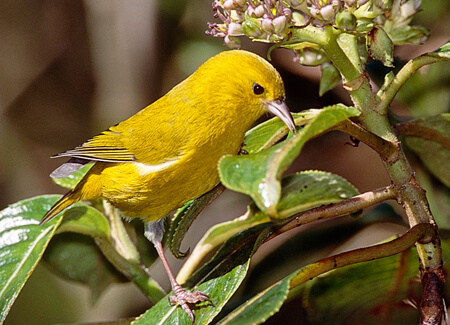 The ‘Anianiau is the smallest of the Hawaiian honeycreepers, a group that includes endangered species such as ‘Akikiki and ‘Akeke‘e. Its common name comes from a Hawaiian word meaning “straight-beaked,” and its scientific name, parvus, comes from the Latin word for “small,” referring to this bird's tiny size.
The ‘Anianiau is the smallest of the Hawaiian honeycreepers, a group that includes endangered species such as ‘Akikiki and ‘Akeke‘e. Its common name comes from a Hawaiian word meaning “straight-beaked,” and its scientific name, parvus, comes from the Latin word for “small,” referring to this bird's tiny size.
Like the I'iwi and Palila, ‘Anianiau were decimated by the introduction of mosquitos to the Hawaiian Islands. Other threats include habitat loss, climate change, introduced invasive plants, and predators such as rats and cats.
Sign up for ABC's eNews to learn how you can help protect birds
Nectar-sipping Native
‘Anianiau are birds on the move, actively feeding on nectar from native trees, including 'ohi'a, and other native and introduced plants. Like other nectar-feeding honeycreepers such as ʻApapane, the ‘Anianiau has a specialized brush-tipped tongue that it rolls into a tube to drink nectar. It may also use its bill to pierce flowers at the base and sip the nectar.
‘Anianiau also gleans arthropods such as caterpillars and spiders from foliage high in the tree canopy. It spends most of its time in the outer foliage of trees, rarely visiting the trunks or larger branches and very rarely, if ever, coming to the ground. It may sometimes forage in small flocks, particularly at rich nectar sources.
Sweet Trills
The male ‘Anianiau sings a high-pitched, sweet-sounding trill from dawn until dusk as it defends its territory. It will vocalize during the entire breeding season, which runs from February to June. Only males are known to sing, but both male and female utter high-pitched calls.

'Anianiau by Peter LaTourrette
Once they pair up, ‘Anianiau build an open-cup nest from mosses, twigs, grass and bark, usually in an 'ohi'a tree. The male will often feed the female as she builds. ‘Anianiau and other Hawaiian honeycreepers frequently steal nest material from each other, even from other active nests, as they build.
The female incubates her clutch of about three eggs for several weeks; during this period the male brings food to the female, who briefly leaves her nest to receive it. Both sexes look after the young, which leave the nest about 18 days after hatching. Like other Hawaiian honeycreepers, ‘Anianiau fledglings have distinctive “juvenile” calls.
Ongoing Conservation Efforts
The ‘Anianiau currently occupies only about 15 percent of its previous range, and is now restricted to mountain ranges mostly above 1,950 feet. Although relatively tolerant of habitat disturbance, the ‘Anianiau is more common in undisturbed native forest, including protected areas such as the Alaka'i Wilderness Preserve.
ABC is keeping abreast of recent advances in biotechnology that aim to modify, suppress, or even eliminate mosquito populations, which could help stop the spread of introduced diseases such as avian malaria that have wiped out so many native Hawaiian birds.
ABC has helped fund rat control efforts on Kaua'i in cooperation with the Kaua'i Forest Bird Recovery Project, with funding from the National Fish and Wildlife Foundation and other organizations. ABC and other conservation groups recently called for Congress to increase conservation funding in the Hawaiian Islands to support critical conservation work—work essential for saving ‘Anianiau and other endangered honeycreepers.
Donate to support ABC's conservation mission!



















































